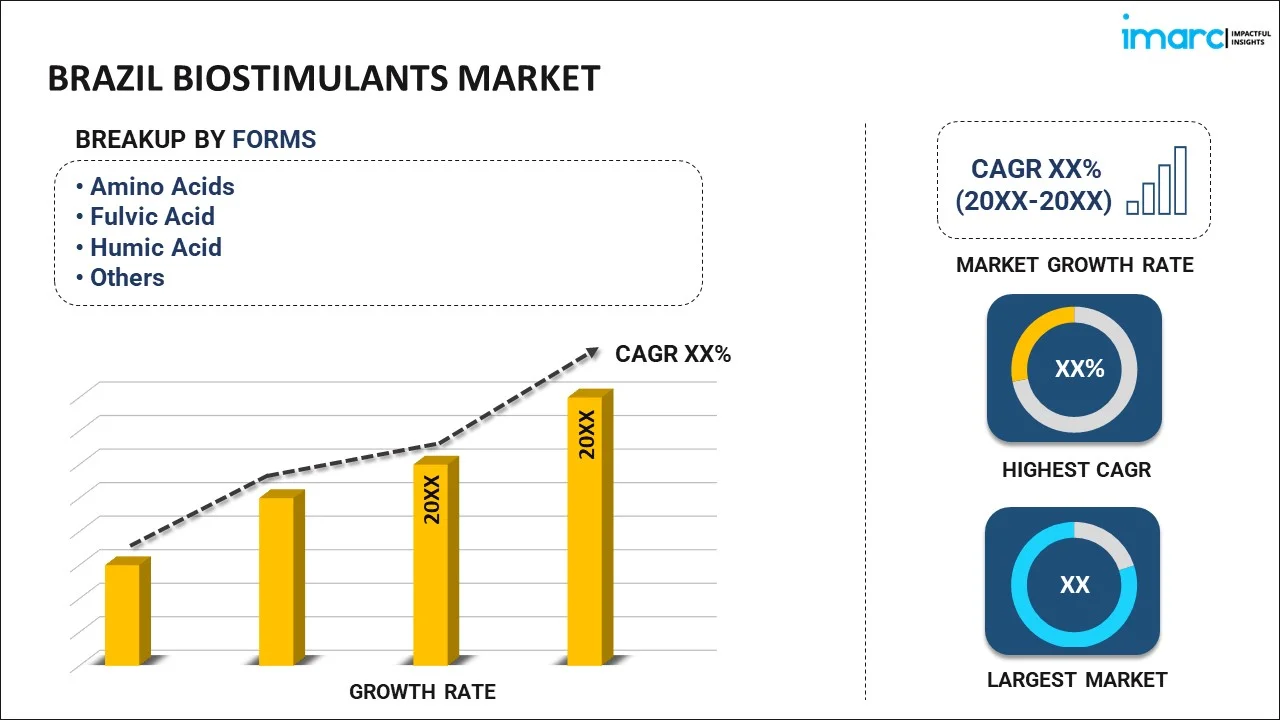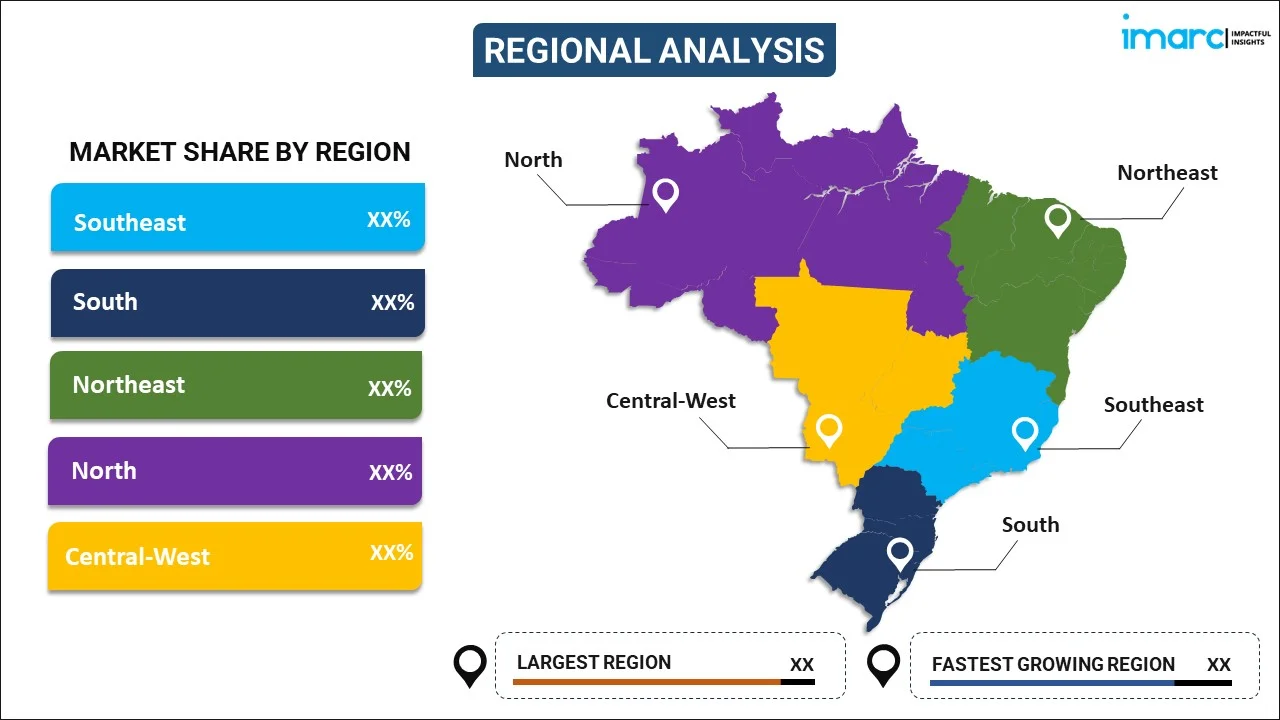
Brazil Biostimulants Market Report by Form (Amino Acids, Fulvic Acid, Humic Acid, Protein Hydrolysates, Seaweed Extracts, and Others), Crop Type (Cash Crops, Horticultural Crops, Row Crops), and Region 2024-2032
Market Overview:
Brazil biostimulants market is projected to exhibit a growth rate (CAGR) of 9.99% during 2024-2032. The growing adoption of sustainable agricultural practices to meet the surging demand for food while minimizing environmental impact, increasing adoption of organic farming practices, and rising technological advancements in formulations and application methods represent some of the key factors driving the market.
|
Report Attribute
|
Key Statistics
|
|---|---|
|
Base Year
|
2023 |
|
Forecast Years
|
2024-2032
|
|
Historical Years
|
2018-2023
|
| Market Growth Rate (2024-2032) | 9.99% |
Biostimulants are applied to plants or the surrounding soil to enhance nutrient uptake, tolerance to abiotic stress (drought or salinity), and overall plant performance. They comprise humic and fulvic acids and amino acid-based biostimulants, which enhance protein synthesis, enzyme activity, and stress tolerance. They also consist of organic compounds, trace elements, and secondary metabolites. They are typically obtained from natural sources, such as seaweed extracts, humic acids, beneficial microorganisms like mycorrhizal fungi, and plant extracts. They work through various mechanisms, including hormone regulation, antioxidant activity, and improving nutrient uptake. Biostimulants align with sustainable farming practices by reducing the reliance on synthetic chemicals and fertilizers, which can have negative environmental impacts. They help crops better withstand adverse conditions, such as drought, extreme temperatures, and salinity. They also enhance the nutritional content, appearance, and shelf life of crops, meeting consumer demand for high-quality produce. They can decrease the need for synthetic fertilizers and pesticides, lowering production costs and minimizing environmental harm. Biostimulants contribute to reduced chemical runoff and environmental contamination, fostering more sustainable agricultural practices. They are utilized in turf grass management as they help maintain healthy, lush lawns by promoting root growth and stress resistance.
Brazil Biostimulants Market Trends:
At present, the increasing awareness about the need for sustainable agricultural practices to meet the demand for food while minimizing environmental impact represents one of the crucial factors impelling the growth of the market in Brazil. Additionally, stringent regulations on chemical fertilizers and pesticides are encouraging farmers to adopt biostimulants as eco-friendly alternatives. Moreover, the increasing adoption of organic farming practices is a significant driver of the market. Organic farming relies heavily on natural inputs and avoids synthetic chemicals, making biostimulants an ideal choice for enhancing crop productivity. In addition, people are increasingly seeking organic products, leading to a rise in the demand for biostimulant-treated crops. Apart from this, climate change and its adverse effects on agriculture are necessitating the use of biostimulants to improve crop resilience. Biostimulants aid in mitigating the impacts of extreme weather events like droughts and heat waves by enhancing the ability of the plant to withstand stress conditions. Furthermore, technological advancements in biostimulant formulations and application methods are contributing to the growth of the market. Innovations in microbial and biochemical biostimulants, as well as the development of precision agriculture techniques, are enhancing the efficacy and efficiency of biostimulant products. These advancements are attracting both large agricultural companies and start-ups to invest in research and development (R&D), thereby improving the functionalities of biostimulants.
Brazil Biostimulants Market Segmentation:
IMARC Group provides an analysis of the key trends in each segment of the market, along with forecasts at the country level for 2024-2032. Our report has categorized the market based on form and crop type.
Form Insights:

- Amino Acids
- Fulvic Acid
- Humic Acid
- Protein Hydrolysates
- Seaweed Extracts
- Others
The report has provided a detailed breakup and analysis of the market based on the form. This includes amino acids, fulvic acid, humic acid, protein hydrolysates, seaweed extracts, and others.
Crop Type Insights:
- Cash Crops
- Horticultural Crops
- Row Crops
A detailed breakup and analysis of the market based on the crop type have also been provided in the report. This includes cash crops, horticultural crops, and row crops.
Regional Insights:

- Southeast
- South
- Northeast
- North
- Central-West
The report has also provided a comprehensive analysis of all the major regional markets, which include Southeast, South, Northeast, North, and Central-West.
Competitive Landscape:
The market research report has also provided a comprehensive analysis of the competitive landscape in the market. Competitive analysis such as market structure, key player positioning, top winning strategies, competitive dashboard, and company evaluation quadrant has been covered in the report. Also, detailed profiles of all major companies have been provided.
Brazil Biostimulants Market Report Coverage:
| Report Features | Details |
|---|---|
| Base Year of the Analysis | 2023 |
| Historical Period | 2018-2023 |
| Forecast Period | 2024-2032 |
| Units | US$ Million |
| Scope of the Report | Exploration of Historical and Forecast Trends, Industry Catalysts and Challenges, Segment-Wise Historical and Predictive Market Assessment:
|
| Forms Covered | Amino Acids, Fulvic Acid, Humic Acid, Protein Hydrolysates, Seaweed Extracts, Others |
| Crop Types Covered | Cash Crops, Horticultural Crops, Row Crops |
| Regions Covered | Southeast, South, Northeast, North, Central-West |
| Customization Scope | 10% Free Customization |
| Report Price and Purchase Option | Single User License: US$ 3699 Five User License: US$ 4699 Corporate License: US$ 5699 |
| Post-Sale Analyst Support | 10-12 Weeks |
| Delivery Format | PDF and Excel through Email (We can also provide the editable version of the report in PPT/Word format on special request) |
Key Questions Answered in This Report:
- How has the Brazil biostimulants market performed so far and how will it perform in the coming years?
- What has been the impact of COVID-19 on the Brazil biostimulants market?
- What is the breakup of the Brazil biostimulants market on the basis of form?
- What is the breakup of the Brazil biostimulants market on the basis of crop type?
- What are the various stages in the value chain of the Brazil biostimulants market?
- What are the key driving factors and challenges in the Brazil biostimulants?
- What is the structure of the Brazil biostimulants market and who are the key players?
- What is the degree of competition in the Brazil biostimulants market?
Key Benefits for Stakeholders:
- IMARC’s industry report offers a comprehensive quantitative analysis of various market segments, historical and current market trends, market forecasts, and dynamics of the Brazil biostimulants market from 2018-2032.
- The research report provides the latest information on the market drivers, challenges, and opportunities in the Brazil biostimulants market.
- Porter's five forces analysis assist stakeholders in assessing the impact of new entrants, competitive rivalry, supplier power, buyer power, and the threat of substitution. It helps stakeholders to analyze the level of competition within the Brazil biostimulants industry and its attractiveness.
- Competitive landscape allows stakeholders to understand their competitive environment and provides an insight into the current positions of key players in the market.
Need more help?
- Speak to our experienced analysts for insights on the current market scenarios.
- Include additional segments and countries to customize the report as per your requirement.
- Gain an unparalleled competitive advantage in your domain by understanding how to utilize the report and positively impacting your operations and revenue.
- For further assistance, please connect with our analysts.
 Inquire Before Buying
Inquire Before Buying
 Speak to an Analyst
Speak to an Analyst
 Request Brochure
Request Brochure
 Request Customization
Request Customization




.webp)




.webp)












